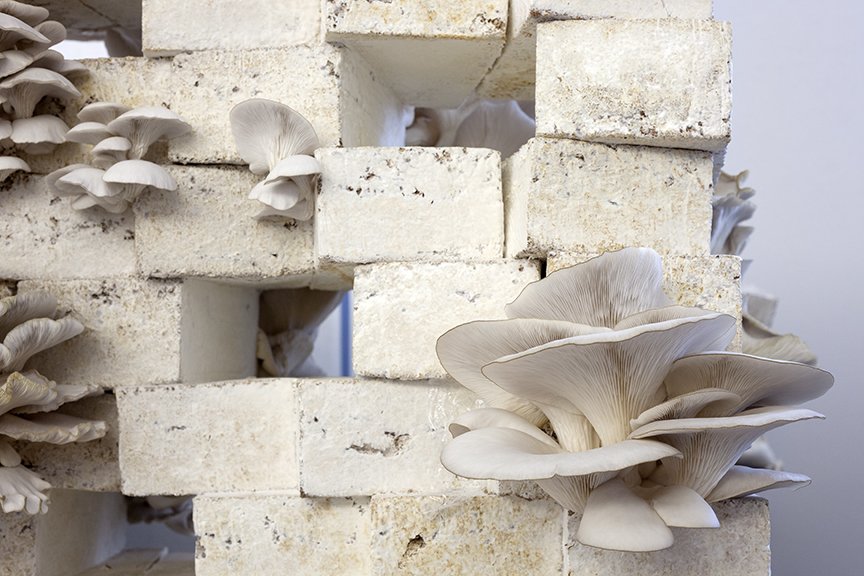Mycelium Mockup
Mycelium Mockup is an edible mycelium installation that uses biotechnology to explore the contradictory relationship of sustainability to market forces in architecture.
The installation is fabricated of cellulosic wood waste and living mycelium, the root structure of mushrooms. This thread-like fungus plays an essential role in the natural world, aiding in the decomposition of materials and converting them to biologically available elements. During the installation, the structural elements of the wall produce edible oyster mushrooms, providing a source of food as well as screen for video projections that investigate the tensions implicit in the desire to control natural processes. At project end, what is not eaten is composted, returning valuable organic matter to the local ecosystem.
The installation provokes fundamental questions about our relationship to architectural materials. Buildings are erected and razed at a frenetic pace in pursuit of ever-increasing returns on investment in contemporary market economies. Architecture determined by revenue models results in materials that are discarded long before the end of their useful life. Rather than building for the ages, sustainability in the context of these rapid cycles of demolition and speculative construction calls for radically biodegradable architectural materials that anticipate their inevitable demolition by encoding organic decay into their basic structure. Mycelium Mockup is an exploration of a next generation material that explores our conflicting aspirations latent in the architectural development of cities.
Fabrication
Mycelium Mockup is fabricated with living mycelium biocomposite blocks. Guide-work controls the location of the blocks during assembly. When fully assembled the individual moist biocomposite blocks grow together into a monolithic structure. The double curvature of the mockup wall stiffens the overall shape, while the rotation of individual blocks maximizes opportunities for masonry cohesion due to chitin growth between masonry courses. The use of selective voids allow multiple views of the city as backdrop and allows for an interplay of light between projectors located on opposite sides of the wall.
Research
The raw materials of Mycelium Mockup consist of heat-sterilized sawdust, nutrients, and pleurotus ostreatus, a mushroom strain native to the Pacific Northwest. The polysaccharide mycelium root structure of the mushroom propagates in the interstitial spaces of the sawdust, binding it together to produce a crosslinked biocomposite building material that is fully biodegradable. A durable white material called chitin forms naturally around the exterior of the blocks, adding to their structural performance. The compressive strength and thermal resistance of the dry mycelium biocomposite blocks is comparable to that of rigid foam insulation.
Project Team
Design Firm
AFJD Studio
Lead Designers
Joe Dahmen
Amber Frid-Jimenez
Design Team
Yan Luo
Joe O’Brien
Joomi Seo
Lianne Zannier
Location
Museum of Vancouver
1100 Chestnut St, Vancouver
BC, Canada
Date
August, 16, 2015
Photography
Krista Jahnke (unless otherwise noted)
Sponsors
University of British Columbia - School of Architecture & Landscape Architecture
UBC SEEDS (Social Ecological Economic Development Studies)
Studio for Extensive Aesthetics
Studio for Form and Energy
Mycelium biocomposite wall installation
Wall detail
Intallation detail
Mycelium biocomposite bricks
Time-lapse of mycelium inoculation in polypropylene growth bag
Compression testing
Mycelium Mockup exhibition at the Museum of Vancouver







